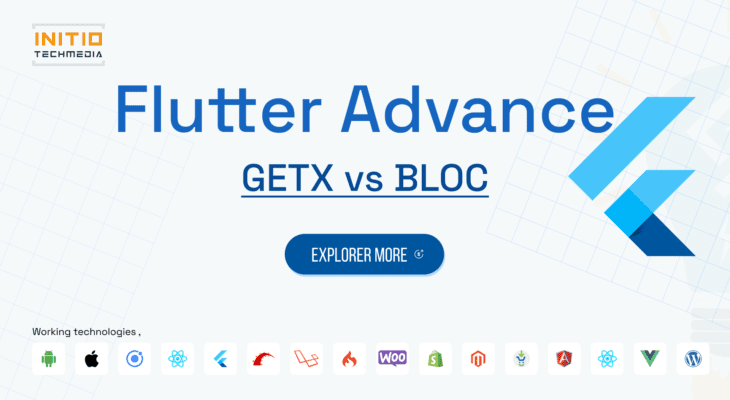Leading Mobile & web Development company which is providing Ready to publish apps & on demands application in Global Bussiness.
- 908, B Square 2, Ambli Rd, near Hotel Double tree Hilton, Vikram NagarAhmedabad-380054, Gujarat, India
- (+91) 8758432204Give us a call
- contact@initiotechmedia.com24/7 online support

Bloc vs GetX: Choosing the Right Flutter State Management Library
- payal patel
- March 22, 2023
- 0
A Detailed Comparison of Pros and Cons to Help You Decide.
Flutter is a popular open-source framework for building cross-platform mobile applications. When building an app, developers often need to choose between different state management solutions to manage their app’s state. Two popular options are Bloc and GetX. In this blog, we’ll explore the differences between the two and help you decide which one to choose for your next Flutter project.
What is Bloc?
Bloc (short for Business Logic Component) is a state management library for Flutter that helps developers manage their app’s state in a predictable way. Bloc is based on the concept of reactive programming, where changes to the state trigger updates to the user interface.
Bloc separates an app’s business logic from the UI, making it easier to test and maintain. Bloc is especially useful for large and complex apps where state management can quickly become unmanageable.
Pros
1.Strong Typing: Bloc provides strong typing, which makes it easier to catch errors during development.
2.Testability: Bloc’s separation of business logic and presentation logic makes it easier to write unit tests for your application.
3. Scalability: Bloc is scalable and can be used in small to large projects, making it suitable for projects of all sizes.
4.Community Support: Bloc has a growing community of developers who contribute to its development, making it more reliable and stable over time.
Cons
1.Learning Curve: Bloc has a steep learning curve, especially for developers who are new to reactive programming.
2.Boilerplate Code: Bloc requires a lot of boilerplate code, which can make it challenging to get started with.
3.Complexity: Bloc can be complex, with a lot of moving parts, which can make it difficult to understand and debug.
What is GetX?
GetX is a state management library for Flutter that provides a simple and lightweight way to manage the state of your app. GetX is based on the concept of dependency injection, which makes it easy to manage the state of your app and inject dependencies.
GetX is designed to be fast and easy to use, which makes it a great option for smaller apps that don’t require a lot of complex state management.
Pros
Ease of Use: GetX is easy to use, with a simple and intuitive API that makes it easy to get started with.
1.Performance: GetX is fast and efficient, with a small footprint that helps to improve the performance of your application.
2.Less Boilerplate Code: GetX requires less boilerplate code than Bloc, making it easier to get started with.
3.Community Support: GetX has a growing community of developers who contribute to its development, making it more reliable and stable over time.
Cons
1.Lack of Strong Typing: GetX does not provide strong typing, which can make it harder to catch errors during development.
2.Less Testability: GetX does not have the same level of separation of concerns as Bloc, which can make it harder to write unit tests.
3.Less Scalability: GetX may not be suitable for large projects with complex state management requirements.
Conclusion
Both Bloc and GetX are powerful state management libraries for Flutter, with their own strengths and weaknesses. Bloc is designed for developers who need a scalable and testable solution for managing state, while GetX is designed for developers who want a lightweight and easy-to-use solution.
Ultimately, the choice between Bloc and GetX will depend on the specific needs of your project. If you need a scalable and testable solution and are willing to invest time in learning a more complex library, then Bloc may be the right choice for you. If you need a lightweight and easy-to-use solution, with less boilerplate code, then GetX may be the better choice.
WhatsApp us

